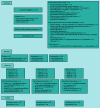Effectiveness of low-dose amitriptyline and mirtazapine in patients with insomnia disorder and sleep maintenance problems: a randomised, double-blind, placebo-controlled trial in general practice (DREAMING)
- PMID: 39814428
- PMCID: PMC12199994
- DOI: 10.3399/BJGP.2024.0173
Effectiveness of low-dose amitriptyline and mirtazapine in patients with insomnia disorder and sleep maintenance problems: a randomised, double-blind, placebo-controlled trial in general practice (DREAMING)
Abstract
Background: Low-dose amitriptyline and mirtazapine are widely prescribed off-label for insomnia disorder. However, evidence of their effectiveness from placebo-controlled studies is lacking.
Aim: To assess the effectiveness of low-dose mirtazapine and amitriptyline in patients with insomnia disorder.
Design and setting: Pragmatic, double-blind, randomised, placebo-controlled trial undertaken in general practices in the Amsterdam region, the Netherlands.
Method: Patients (aged 18-85 years) with insomnia disorder and sleep maintenance problems for whom non-pharmacological treatment was insufficient were randomised to mirtazapine (7.5-15 mg/day), amitriptyline (10-20 mg/day), or placebo for 16 weeks (optional double-dose regimen in week 2-14). Insomnia Severity Index (ISI) scores (range 0-28) were assessed at baseline and again at 6, 12, 20, and 52 weeks. The primary outcome was an ISI total score at 6 weeks that was clinically relevant and signified either 'improvement' (>7 points lower than baseline) or 'recovery' (total score ≤10 points).
Results: In total, 80 participants were included. At 6 weeks, in the intention-to-treat analyses, mirtazapine and amitriptyline each led to statistically significantly lower ISI scores when compared with placebo: mirtazapine mean difference = -6.0 points (95% confidence interval [CI] = -9.0 to -3.0), amitriptyline mean difference = -3.4 points (95% CI = -6.3 to -0.4). At 6 weeks mirtazapine resulted in statistically significantly higher improvement and recovery rates (52% and 56%, respectively) compared with placebo (both 14%), whereas amitriptyline (with rates of 40% and 36%, respectively) did not. From 12 weeks onwards no statistically significant differences in ISI scores were observed.
Conclusion: Compared with placebo, low-dose mirtazapine provided a statistically significant and clinically relevant reduction of insomnia severity at 6 weeks, but not at later time points. Low-dose amitriptyline resulted in a statistically significant reduction at 6 weeks, but this was not clinically relevant. The results do not support the prescription of low-dose amitriptyline and mirtazapine for several months in patients with insomnia disorder in general practice. Based on the results, GPs may consider prescribing off-label low-dose mirtazapine for a period of about 6 weeks in case non-pharmacological treatment is insufficient.
Keywords: amitriptyline; insomnia; mirtazapine; primary health care.
© The Authors.
Conflict of interest statement
Competing interests: The authors have declared no competing interests.
Figures


References
-
- Ohayon MM. Epidemiology of insomnia: what we know and what we still need to learn. Sleep Med Rev. 2002;6(2):97–111. - PubMed
-
- American Psychiatric Association. Diagnostic and statistical manual of mental disorders. 5th edn. Washington, DC: American Psychiatric Association; 2013.
-
- Riemann D, Baglioni C, Bassetti C, et al. European guideline for the diagnosis and treatment of insomnia. J Sleep Res. 2017;26(6):675–700. - PubMed
Publication types
MeSH terms
Substances
LinkOut - more resources
Full Text Sources
Medical
